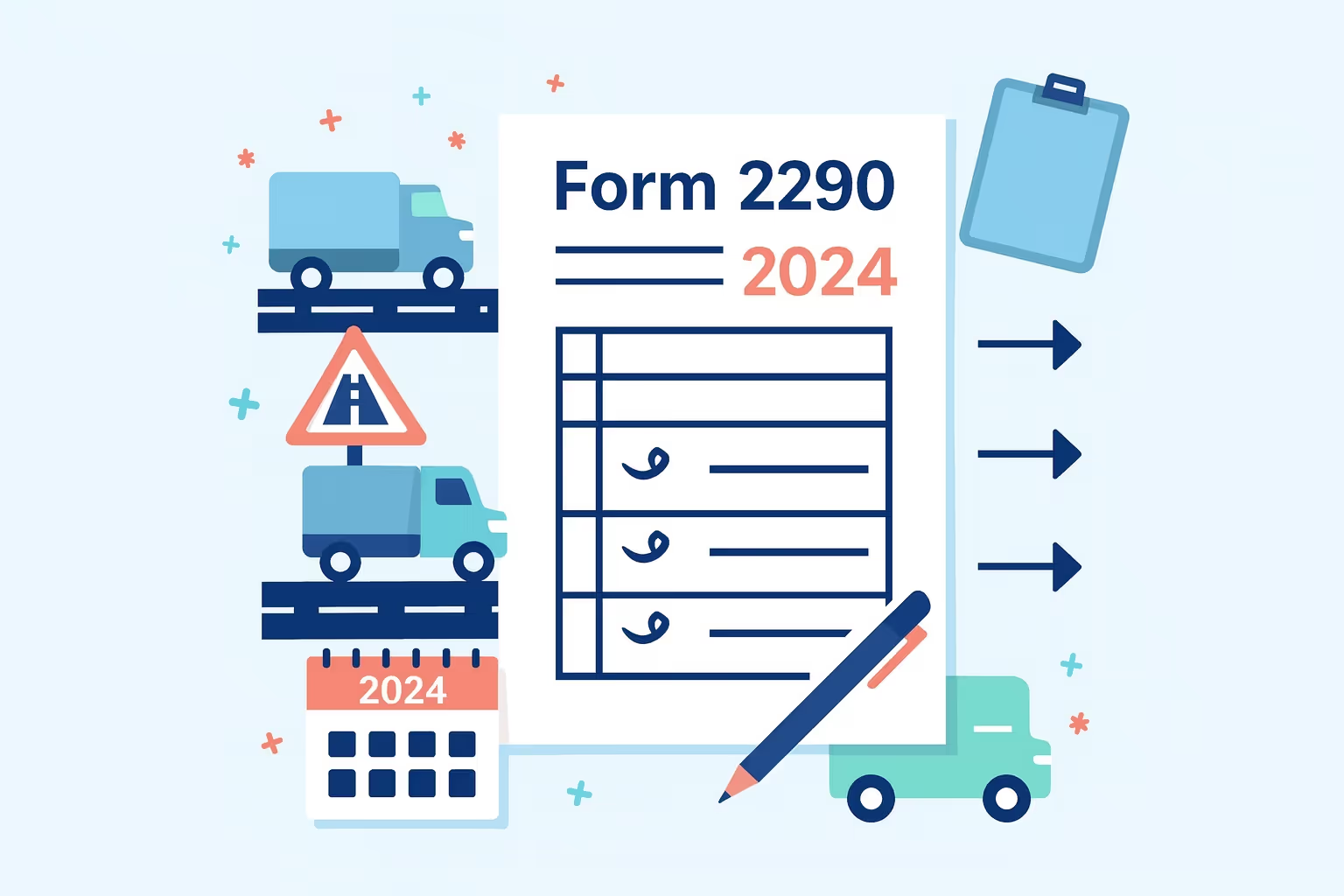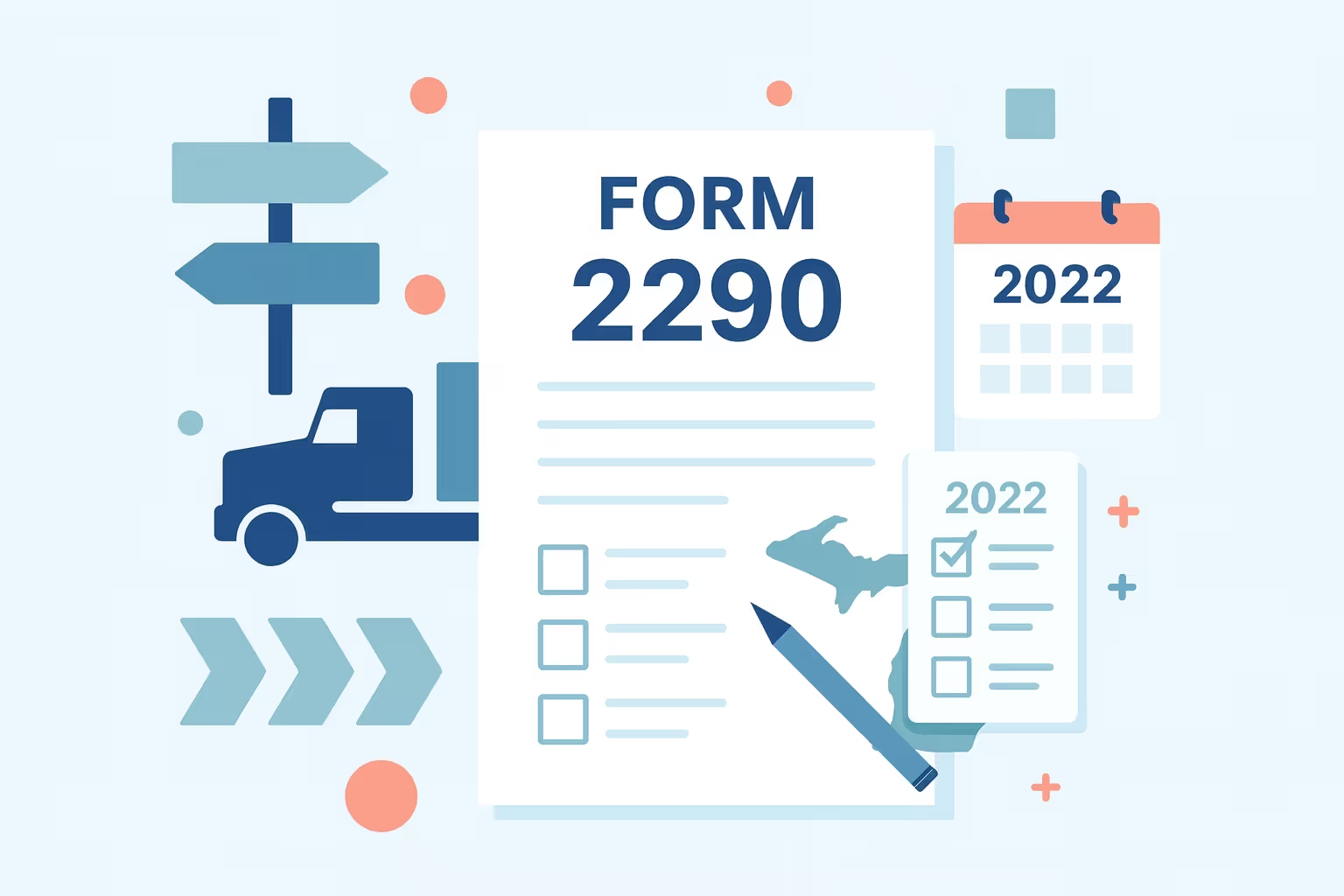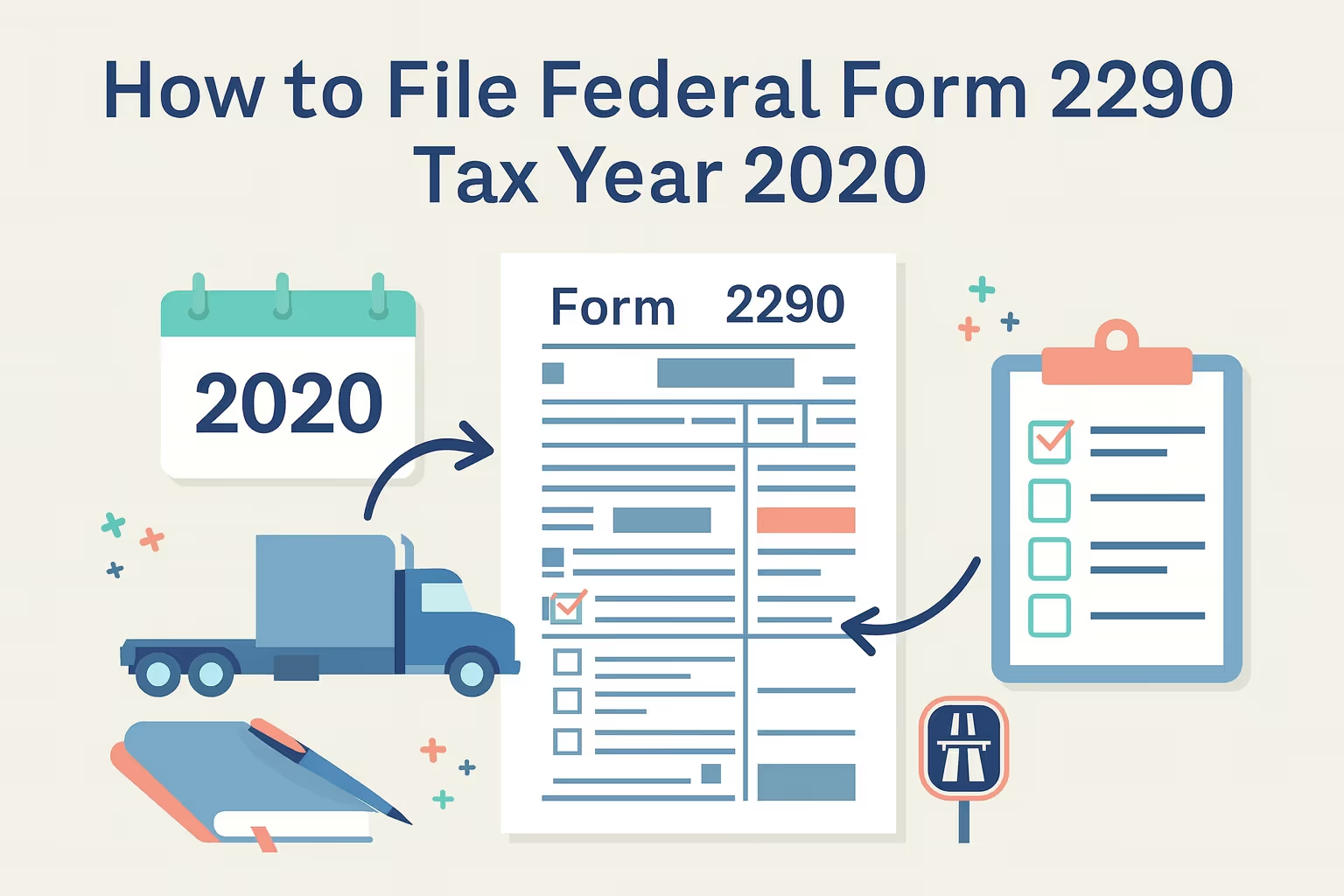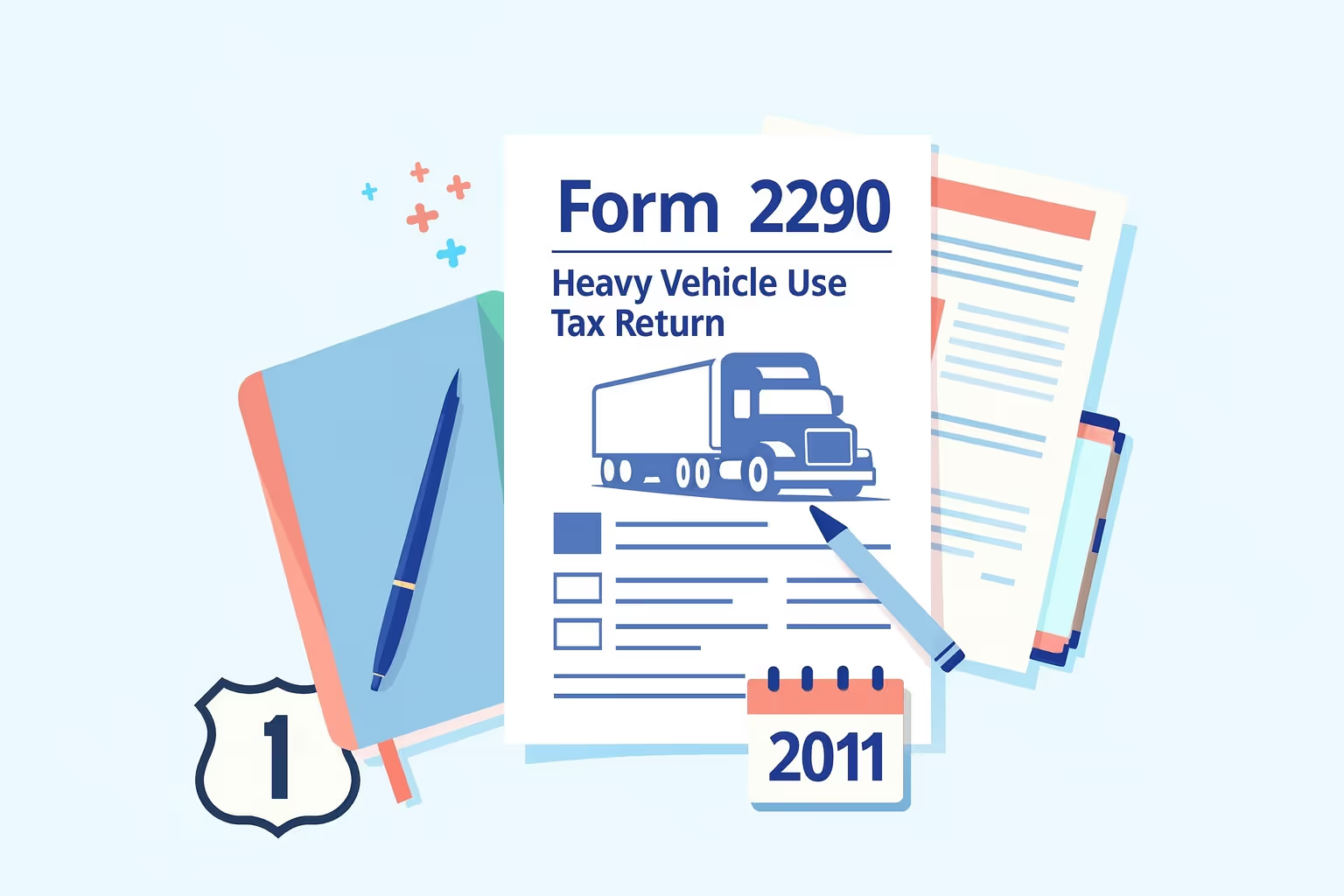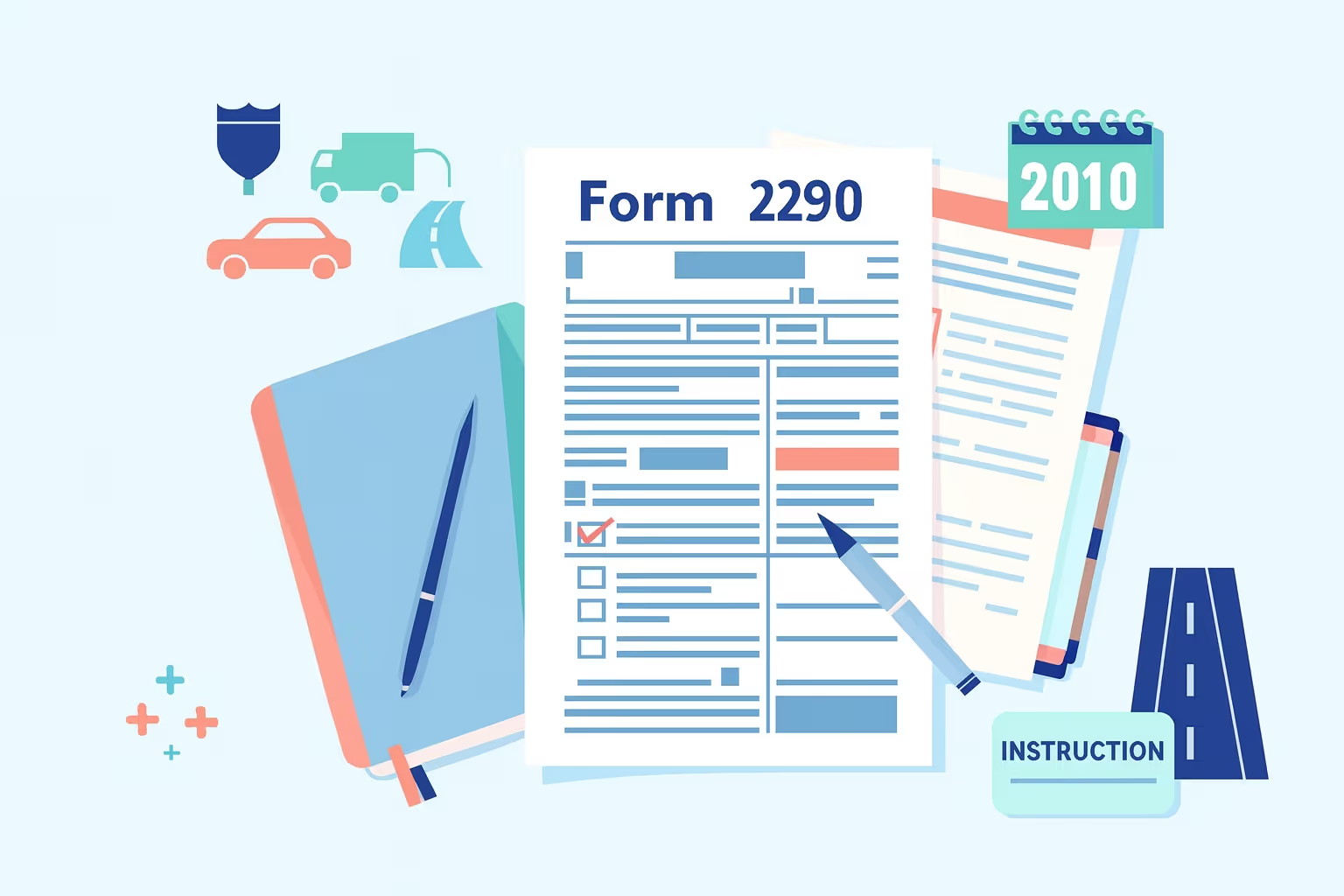Form 2290 2017 Instructions: How to File Step by Step?
Form 2290 is a federal tax form issued by the Internal Revenue Service for owners and operators of heavy highway vehicles. It is used to report and pay the heavy vehicle use tax, which helps fund highway maintenance nationwide. For the 2017 tax year, the form covers the tax period from July 1, 2017, to June 30, 2018. Any person who operates or registers a vehicle with a taxable gross weight of 55,000 pounds or more must file this tax return.
This guide explains how to complete and file Form 2290 accurately and correctly. It outlines filing options, payment methods, and requirements such as providing an Employer Identification Number and vehicle identification number. It also helps filers understand key terms, such as taxable vehicle, claim suspension, and proof of payment, ensuring compliance with the Internal Revenue Code. The article is structured to support truck owners and other filers who may be handling this process for the first time.
By following these instructions, filers can avoid common errors, submit accurate information, and receive timely confirmation of their Schedule 1. The guide also covers how to report taxable vehicle acquisitions, suspended vehicles, and changes in gross weight. With proper preparation and attention to detail, anyone can complete the form confidently and meet IRS requirements for the 2017 tax year.
What Is Form 2290 and Who Needs to File It?
Form 2290 is a federal tax document used by the Internal Revenue Service to collect the heavy vehicle use tax from owners and operators of large commercial vehicles. The tax applies to highway motor vehicles with a taxable gross weight of 55,000 pounds or more that operate on public highways during a specific tax period. This form ensures that heavy vehicles contribute fairly to the maintenance and construction of national roadways.
Understanding the Heavy Highway Vehicle Use Tax (HVUT)
The Heavy Highway Vehicle Use Tax, or HVUT, is part of the federal excise tax system established under the Internal Revenue Code. It applies to heavy highway vehicles such as trucks, truck tractors, and buses that are registered in a person’s or business’s name and are used for commercial operations on public highways. The amount of tax owed depends on the taxable gross weight of each vehicle and the month the vehicle is first used during the tax year.
Vehicles that typically fall below the 55,000-pound threshold, such as pickup trucks, vans, and smaller vehicles, are exempt from this tax. The funds collected through the HVUT help maintain and improve the U.S. highway system, ensuring safer and more efficient transportation routes.
Who Must File Form 2290?
The Internal Revenue Service requires any person or business that registers a heavy highway vehicle with a taxable gross weight of 55,000 pounds or more to file Form 2290 for each tax year. Filing is mandatory even if the car is used only for part of the period.
Individuals or entities must file if they meet any of the following conditions:
- A vehicle is registered or required to be registered in its name under state law.
- The vehicle is used on public highways during the current tax period.
- The vehicle meets the taxable gross weight threshold of 55,000 pounds or more.
Certain vehicles may qualify for special conditions or reduced tax rates, including:
- Agricultural vehicles that operate primarily for farming purposes and travel limited miles annually.
- Logging vehicles are used exclusively to transport harvested forest products.
- Suspended vehicles that do not exceed the mileage use limit of 5,000 miles (or 7,500 miles for agricultural vehicles).
Each filer must have an Employer Identification Number to complete the tax return. Social Security Numbers cannot be used on this form. For first-time filers, obtaining an EIN before submitting the return is necessary. Vehicles that are newly purchased or transferred are considered taxable vehicle acquisitions and must be reported for the month they are first operated on public highways.
Correctly identifying whether a vehicle is taxable, suspended, or exempt helps ensure the accuracy of the tax return. Truck owners and fleet operators should review IRS guidelines annually to confirm current filing requirements and due dates.
Key Details for the 2017 Tax Year
The 2017 tax year for Form 2290 began on July 1, 2017, and ended on June 30, 2018. During this period, every filer who operated a highway motor vehicle with a taxable gross weight of 55,000 pounds or more was required to file a tax return with the Internal Revenue Service. Understanding these yearly details ensures accurate and timely filing.
Important filing details for the 2017 tax year include:
- Tax period: The tax year runs from July 1, 2017, through June 30, 2018, and applies to all vehicles first used during this period.
- Due date: The form must be filed by the last day of the month following the vehicle’s first use. For example, vehicles first operated in July 2017 were due by August 31, 2017.
- Electronic filing requirement: E-filing is mandatory for any filer reporting 25 or more taxable vehicles. Those with fewer vehicles are encouraged to e-file for faster processing.
- EIN Requirement: All filers must use an Employer Identification Number (EIN) to file their tax return. The IRS does not accept a Social Security Number in its place.
- IRS resources: All current forms, schedules, and instructions are available on the official IRS website.
Understanding these points helps filers avoid errors and ensures compliance with the rules established by the Internal Revenue Code for the heavy vehicle use tax.
Step-by-Step Instructions for Completing Form 2290
Filing Form 2290 correctly requires gathering the correct information, understanding vehicle classifications, and following the IRS layout step-by-step. Completing the form accurately helps prevent rejections and delays.
Step 1 – Gather Required Information.
Each filer must collect all relevant details before starting the form. This includes:
- Employer Identification Number and business contact information.
- Vehicle Identification Numbers for each taxable vehicle.
- The taxable gross weight of each vehicle determines the amount of tax owed.
- The date each vehicle was first used on public highways during the tax period.
- Mileage records for vehicles that may qualify for suspension under mileage use limits.
Having complete and accurate information ensures the tax return matches vehicle registration and IRS records.
Step 2 – Determine Vehicle Category.
Filers must classify each vehicle correctly before entering tax details. Categories include:
- Taxable vehicles: These are vehicles with a taxable gross weight of 55,000 pounds or more used on public highways.
- Suspended vehicles: These are vehicles that are expected to operate below the mileage use limit of 5,000 miles or 7,500 miles for agricultural vehicles.
- Logging vehicles: These are used exclusively for logging operations and may qualify for a reduced tax rate.
Classifying vehicles correctly helps calculate the proper tax and avoid penalties for incorrect reporting.
Step 3 – Fill Out the Form.
Each filer should complete all relevant sections of Form 2290 in the following order:
- Form header: Provide identifying information, including name, address, Employer Identification Number, and applicable checkboxes for return type or changes.
- Part I – Figuring the Tax: Enter the month of first use, the total tax for all vehicles, and any credits or adjustments.
- Part II – Suspension Statement: Complete this section if claiming suspension for low-mileage vehicles.
- Tax computation: Use the IRS tax tables to calculate the total based on the vehicle’s category and first-use month.
Step 4 – Review Before Submission.
Before submitting, filers should:
- Verify Vehicle Identification Numbers and gross weights.
- Ensure that all vehicle categories and suspension statements are entered correctly.
- Confirm the correct tax period and total tax due.
A careful review minimizes processing delays and reduces the likelihood of rejection.
Filing Options — E-Filing vs. Paper Filing
The Internal Revenue Service offers two filing methods for Form 2290: e-filing and paper filing. Choosing the appropriate method depends on the number of vehicles being reported and the filer’s preference.
E-Filing (Electronic Filing)
Electronic filing is the preferred method for most filers and is mandatory for those reporting 25 or more taxable vehicles.
Key features of e-filing include:
- Faster processing: E-filed forms are typically approved within minutes, and the stamped Schedule 1 can be downloaded immediately.
- Fewer errors: Electronic systems automatically check for missing or inconsistent information.
- Direct payment options: Payments can be made through electronic funds withdrawal or the Electronic Federal Tax Payment System.
- Immediate proof of payment: Filers receive an electronic copy of the stamped Schedule 1 for vehicle registration purposes.
Paper Filing
Paper filing is available for those reporting fewer than 25 vehicles.
Steps for paper filing include:
- Completing all parts of the tax form and both copies of Schedule 1.
- Attach a check or money order with Form 2290-V if paying by mail.
- Mailing returns to the IRS address corresponding to the payment method.
- Allowing several weeks for processing and return of the stamped Schedule 1 by mail.
Choosing the Right Method
While both options are accepted, e-filing provides faster confirmation and fewer errors. Paper filing may be preferred by those who lack internet access or who like to maintain traditional recordkeeping systems. Regardless of method, filers must ensure accuracy and submit the form by the due date to remain compliant with IRS requirements.
How to Pay the Heavy Vehicle Use Tax?
The Internal Revenue Service provides several methods for paying the heavy vehicle use tax. Each filer must choose the method that best fits their filing process. Payments must be made in full when submitting the tax return, as partial payments are not accepted.
Available payment methods include:
- Electronic Funds Withdrawal (Direct Debit): This option is available only for those filing electronically. It allows the IRS to withdraw the payment directly from the filer’s bank account on the date selected during the e-filing process.
- Electronic Federal Tax Payment System (EFTPS): Filers can schedule and submit payments online or by phone through EFTPS.gov. Registration is required before making a payment.
- Check or Money Order: Paper filers may mail their payment with Form 2290-V, the payment voucher. Checks must be made payable to “United States Treasury” and include the Employer Identification Number, tax period, and form number on the memo line.
Payment tips:
- Confirm that the payment amount matches the total tax calculated on Form 2290.
- Keep proof of payment, such as a confirmation number or stamped Schedule 1.
- Schedule EFTPS payments at least one day before the due date to ensure timely processing.
Timely and accurate payments prevent penalties and help ensure the IRS processes the stamped Schedule 1 without delay.
Required Attachments and Schedules
Filers must include specific attachments with Form 2290 to complete their submission. These documents confirm the details of taxable vehicles and provide proof of tax payment or exemption.
Required attachments include:
- Schedule 1 – Proof of Payment: Every filer must complete two copies of Schedule 1. The schedule lists all taxable and suspended vehicles, along with their Vehicle Identification Numbers and weight categories. The IRS stamps and returns one copy as proof of payment.
- Form 2290-V – Payment Voucher: This voucher must be included when submitting a paper return with a check or money order.
- Supporting documentation: Filers claiming credits or suspensions must attach proof of eligibility. This may include documents showing that a vehicle was sold, stolen, destroyed, or not used on public highways.
Vehicle categories listed on Schedule 1 include:
- Categories A through V for taxable vehicles with increasing gross weight ranges.
- Category W for suspended vehicles is expected to stay under the mileage use limit.
Each form and attachment must match the filer’s information, Employer Identification Number, and tax period. Complete documentation ensures smooth processing and prevents delays in correspondence with the IRS.
Common Filing Errors and How to Avoid Them?
Filing Form 2290 requires careful attention to detail to prevent errors that can delay processing or result in penalties. Many mistakes occur due to incorrect information, miscalculations, or missing attachments.
Common filing errors include:
- Incorrect identification details: Using a Social Security Number instead of an Employer Identification Number will cause rejection since the IRS requires an EIN for all filers.
- Vehicle information errors: Entering the wrong Vehicle Identification Number or taxable gross weight can result in inaccurate tax computation and delayed processing.
- Failing to include Schedule 1: Both copies must be attached when filing by mail.
- Selecting the wrong tax period or due date: Filers must confirm the correct filing period, which is July 1, 2017, through June 30, 2018.
- Incorrect payment or partial payment: The full tax amount must accompany the return.
- Late filing: Submissions after the due date are subject to penalties and interest.
How to avoid errors:
- Double-check vehicle details and Employer Identification Number.
- Use the correct tax computation table for the 2017 tax year.
- File electronically to minimize errors through system validation.
- Keep copies of all submitted forms and proof of payment for records.
Accurate and timely filing ensures compliance with the Internal Revenue Service and helps truck owners maintain valid vehicle registration and operating authority.
Special Situations — Suspended or Inactive Vehicles
Not every heavy vehicle is subject to tax payment each year. Some vehicles may qualify for suspension from the heavy vehicle use tax if they meet specific mileage and use conditions. Understanding when Form 2290 filing is required and when suspension applies helps filers avoid unnecessary payments or compliance issues.
When Form 2290 does not need to be filed:
- The filer did not own or operate any vehicle with a taxable gross weight of 55,000 pounds or more during the tax period.
- Vehicles were not used on public highways at any time during the filing period.
- All vehicles qualified for exemption or were registered in categories not subject to the heavy vehicle use tax.
Reporting suspended or low-mileage vehicles:
- Vehicles may be reported as suspended if their use on public highways is expected to stay under 5,000 miles for general vehicles or 7,500 miles for agricultural vehicles.
- Filers must complete Part II, Suspension Statement, to claim suspension for these vehicles.
- Suspended vehicles are listed on Schedule 1 under Category W.
If the mileage limit is exceeded:
- Filers must file an amended return and pay the full tax for that vehicle for the tax period.
- The amendment should report when the vehicle exceeded the mileage use limit and include the additional tax owed.
Recordkeeping requirements:
- Maintain daily mileage logs, trip sheets, and maintenance records to ensure accurate documentation and compliance with regulations.
- Keep documentation for at least three years after the tax period ends to prove suspension eligibility.
Properly reporting suspended or inactive vehicles ensures accurate filing and protects the filer from penalties or disputes with the Internal Revenue Service.
Tips for First-Time Filers
Filing Form 2290 for the first time can seem complicated, but understanding key requirements simplifies the process. First-time filers should prepare all information and documents before beginning.
Checklist before filing:
- Obtain an Employer Identification Number if one has not been issued.
- Gather vehicle information, including Vehicle Identification Numbers, taxable gross weight, and first-use dates.
- Determine whether each vehicle qualifies as taxable, suspended, or exempt.
- Choose between e-filing and paper filing based on the number of vehicles reported.
Additional tips for new filers:
- Review the IRS Form 2290 instructions to understand line-by-line requirements.
- Use e-file options when possible to reduce errors and receive faster confirmation.
- Double-check mileage use limits and properly complete any claim suspension sections.
- Keep proof of payment and copies of all submitted forms for future reference.
Accurate preparation and submission help first-time filers avoid errors, penalties, and delays in receiving proof of payment. Filing early in the tax period allows time to correct any issues before deadlines.
Importance of the IRS-Stamped Schedule 1
The stamped Schedule 1 is one of the most critical documents associated with Form 2290. It serves as official proof that the heavy vehicle use tax has been paid or that the filer has properly reported a suspension.
Why is Schedule 1 crucial?
- It is required for vehicle registration with state Departments of Motor Vehicles.
- It must be presented for interstate or international travel when transporting commercial goods.
- It acts as evidence of compliance with federal tax requirements under the Internal Revenue Code.
How to obtain Schedule 1?
- E-filers receive a stamped electronic copy immediately after the IRS accepts the return.
- Paper filers must submit two copies of Schedule 1 with their return. The IRS will stamp and return one copy by mail.
Replacing a lost or damaged Schedule 1:
- Filers should contact the IRS office where the form was processed and provide identifying information such as the Employer Identification Number, name, and tax period.
- Replacement requests may take several weeks to process.
Maintaining multiple copies of the stamped Schedule 1 is essential for vehicle registration, audits, or verification purposes. Proper handling of this document confirms compliance and prevents issues when renewing registrations or operating across state lines.
Frequently Asked Questions
What are the Form 2290 2017 instructions for filing the heavy vehicle use tax?
The Form 2290 2017 instructions require every person who owns or operates a heavy highway vehicle with a taxable gross weight of 55,000 pounds or more to file an IRS form for the correct tax period. Truck owners must include their Employer Identification Number (EIN), Vehicle Identification Number (VIN), and payment information. E-filing is recommended for faster processing and immediate proof of payment from the Internal Revenue Service.
Who must file Form 2290, and what is considered a taxable vehicle?
Any person who registers a highway motor vehicle with a taxable gross weight of 55,000 pounds or more must file Form 2290 each tax year. A taxable vehicle is one used on public highways during the tax period. Agricultural vehicles and logging vehicles may qualify for special conditions or reduced rates if they operate within the mileage use limit.
What should a filer do if a taxable vehicle is sold or transferred?
When a taxable vehicle is sold, stolen, or destroyed during the tax period, the filer may claim a credit for the tax paid on that vehicle. The filer must report the acquisition or sale using the appropriate IRS form and provide supporting proof. This ensures accurate adjustments and compliance with Internal Revenue Code requirements for the following year.
How can a filer claim suspension for low-mileage vehicles?
A filer can claim suspension by completing the suspension statement on Form 2290 if a vehicle is expected to operate 5,000 miles or less, or 7,500 miles for agricultural vehicles, during the tax year. These vehicles must still be listed on Schedule 1 as proof of reporting. If mileage use limits are exceeded, the filer must amend the return and pay the full tax.
What information is needed to file Form 2290 correctly?
To complete Form 2290, a filer must provide the Employer Identification Number, Vehicle Identification Number for each truck, taxable gross weight, and the date each vehicle was first used. Filers should also include proof of payment, mileage records, and any relevant documentation related to claim suspension. Accurate and complete information ensures smooth IRS processing and prevents errors in filing.
How can a filer correct an error or request proof of payment?
If an error occurs or proof of payment is needed, the filer should contact the Internal Revenue Service office or the e-file provider that processed the tax form. The filer must provide identifying details such as the Employer Identification Number, tax year, and vehicle information. The IRS can reissue Schedule 1 by mail or through its website once verification is complete.
















